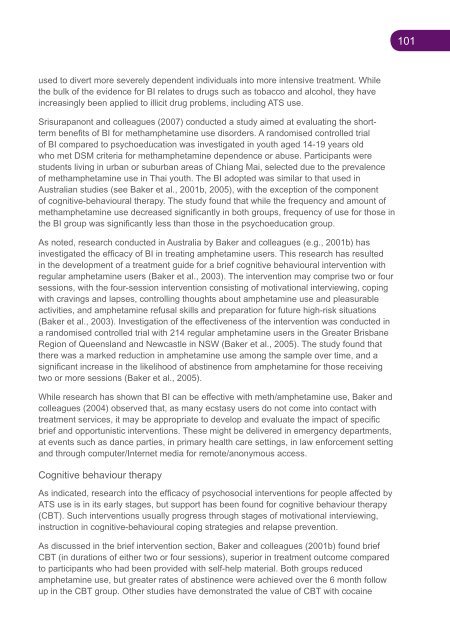National Amphetamine-Type Stimulant Strategy Background Paper
National Amphetamine-Type Stimulant Strategy Background Paper
National Amphetamine-Type Stimulant Strategy Background Paper
Create successful ePaper yourself
Turn your PDF publications into a flip-book with our unique Google optimized e-Paper software.
101<br />
used to divert more severely dependent individuals into more intensive treatment. While<br />
the bulk of the evidence for BI relates to drugs such as tobacco and alcohol, they have<br />
increasingly been applied to illicit drug problems, including ATS use.<br />
Srisurapanont and colleagues (2007) conducted a study aimed at evaluating the shortterm<br />
benefits of BI for methamphetamine use disorders. A randomised controlled trial<br />
of BI compared to psychoeducation was investigated in youth aged 14-19 years old<br />
who met DSM criteria for methamphetamine dependence or abuse. Participants were<br />
students living in urban or suburban areas of Chiang Mai, selected due to the prevalence<br />
of methamphetamine use in Thai youth. The BI adopted was similar to that used in<br />
Australian studies (see Baker et al., 2001b, 2005), with the exception of the component<br />
of cognitive-behavioural therapy. The study found that while the frequency and amount of<br />
methamphetamine use decreased significantly in both groups, frequency of use for those in<br />
the BI group was significantly less than those in the psychoeducation group.<br />
As noted, research conducted in Australia by Baker and colleagues (e.g., 2001b) has<br />
investigated the efficacy of BI in treating amphetamine users. This research has resulted<br />
in the development of a treatment guide for a brief cognitive behavioural intervention with<br />
regular amphetamine users (Baker et al., 2003). The intervention may comprise two or four<br />
sessions, with the four-session intervention consisting of motivational interviewing, coping<br />
with cravings and lapses, controlling thoughts about amphetamine use and pleasurable<br />
activities, and amphetamine refusal skills and preparation for future high-risk situations<br />
(Baker et al., 2003). Investigation of the effectiveness of the intervention was conducted in<br />
a randomised controlled trial with 214 regular amphetamine users in the Greater Brisbane<br />
Region of Queensland and Newcastle in NSW (Baker et al., 2005). The study found that<br />
there was a marked reduction in amphetamine use among the sample over time, and a<br />
significant increase in the likelihood of abstinence from amphetamine for those receiving<br />
two or more sessions (Baker et al., 2005).<br />
While research has shown that BI can be effective with meth/amphetamine use, Baker and<br />
colleagues (2004) observed that, as many ecstasy users do not come into contact with<br />
treatment services, it may be appropriate to develop and evaluate the impact of specific<br />
brief and opportunistic interventions. These might be delivered in emergency departments,<br />
at events such as dance parties, in primary health care settings, in law enforcement setting<br />
and through computer/Internet media for remote/anonymous access.<br />
Cognitive behaviour therapy<br />
As indicated, research into the efficacy of psychosocial interventions for people affected by<br />
ATS use is in its early stages, but support has been found for cognitive behaviour therapy<br />
(CBT). Such interventions usually progress through stages of motivational interviewing,<br />
instruction in cognitive-behavioural coping strategies and relapse prevention.<br />
As discussed in the brief intervention section, Baker and colleagues (2001b) found brief<br />
CBT (in durations of either two or four sessions), superior in treatment outcome compared<br />
to participants who had been provided with self-help material. Both groups reduced<br />
amphetamine use, but greater rates of abstinence were achieved over the 6 month follow<br />
up in the CBT group. Other studies have demonstrated the value of CBT with cocaine

















